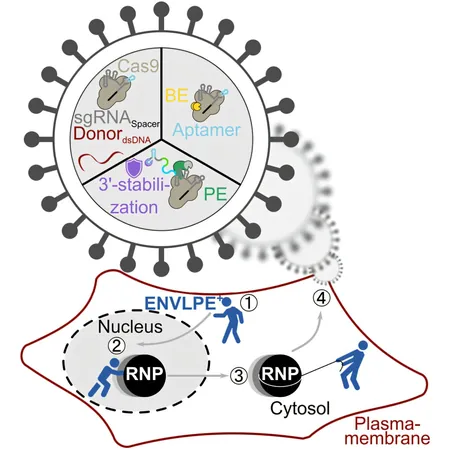
Revolutionary Delivery Tech Transforms CRISPR: Vision Restoration Breakthrough in Mice
2025-04-09
Author: Wei
A Game Changer in Gene Editing!
An innovative research team from Helmholtz Munich and the Technical University of Munich has unveiled a groundbreaking delivery system that supercharges the efficiency of CRISPR/Cas9 gene-editing tools. This cutting-edge technology, known as ENVLPE, employs engineered, non-infectious virus-like particles to surgically correct faulty genes. The incredible success of this system has been demonstrated in blind mice afflicted by genetic mutations.
Unlocking New Potential in Cancer Treatments
But that’s not all—ENVLPE is set to revolutionize cancer therapy too! By enabling precise genetic modifications of immune cells, this technology promises to make treatments more universally applicable, offering a beacon of hope for many cancer patients who currently lack effective options.
Tackling the Challenges of Delivery in Gene Editing
Gene editing with CRISPR holds monumental potential for treating genetic disorders, yet the delivery of these molecular tools into target cells has long posed a daunting challenge. Dr. Dong-Jiunn Jeffery Truong, a leading researcher in the study, explains, "Traditional delivery systems like adeno-associated viruses (AAVs) and lipid nanoparticles struggle with effectiveness and the risk of immune reactions. ENVLPE tackles these issues head-on, while remaining adaptable for future genetic advancements."
How ENVLPE Works its Magic
The ENVLPE system is ingeniously crafted from modified virus shells, serving as carriers for advanced gene-editing tools. This innovation ensures that fully assembled gene editors are packed and shielded from degradation during transit, allowing for accurate delivery into target cells where necessary edits can be performed. In contrast to older methods that often relied on incomplete or ineffective edits, ENVLPE guarantees high delivery efficiency.
Restoring Sight: A Remarkable Achievement
In a stunning experiment conducted in collaboration with Professor Krzysztof Palczewski from UC Irvine, the team tested ENVLPE on mice suffering from inherited blindness due to a defective Rpe65 gene. After administering ENVLPE, these mice not only responded to light stimuli but showed remarkable improvements in vision.
The Astonishing Results Explained
"The extent of restoration was astounding," remarked Julian Geilenkeuser, a doctoral researcher involved in the project. ENVLPE outperformed competing systems by achieving significant results with fewer doses—over ten times less than conventional methods.
Paving the Way for Universal Cancer Treatments
Beyond vision restoration, ENVLPE opens doors for next-gen adoptive T cell therapies. This technology allows for the targeted modification of T cells, making them 'universal' and eliminating the need for personalized treatments. This is a crucial step toward making gene therapies more accessible and affordable.
Preparing for Clinical Implementation
With the promise of enhancing the delivery of gene-editing tools, the research team is focusing on refining ENVLPE for clinical use. They plan to leverage nature’s diversity and AI advancements in protein design to further hone targeting precision, ensuring these tools reach specific cell types.
Funding Pathway to Patient Solutions
To bring ENVLPE to the clinic, the team is exploring funding options through grants and partnerships with the pharmaceutical industry. Their ultimate aim is to optimize this revolutionary technology for various treatments and make it available to patients.
A Bright Future for Gene Therapy!
As highlighted by Prof. Gil Westmeyer, the ENVLPE system marks a substantial leap toward on-demand, precise genetic modifications in complex cellular models. This innovative approach exemplifies how synthetic biology can spearhead future medical breakthroughs, heralding a new era in gene therapy.






 Brasil (PT)
Brasil (PT)
 Canada (EN)
Canada (EN)
 Chile (ES)
Chile (ES)
 Česko (CS)
Česko (CS)
 대한민국 (KO)
대한민국 (KO)
 España (ES)
España (ES)
 France (FR)
France (FR)
 Hong Kong (EN)
Hong Kong (EN)
 Italia (IT)
Italia (IT)
 日本 (JA)
日本 (JA)
 Magyarország (HU)
Magyarország (HU)
 Norge (NO)
Norge (NO)
 Polska (PL)
Polska (PL)
 Schweiz (DE)
Schweiz (DE)
 Singapore (EN)
Singapore (EN)
 Sverige (SV)
Sverige (SV)
 Suomi (FI)
Suomi (FI)
 Türkiye (TR)
Türkiye (TR)
 الإمارات العربية المتحدة (AR)
الإمارات العربية المتحدة (AR)